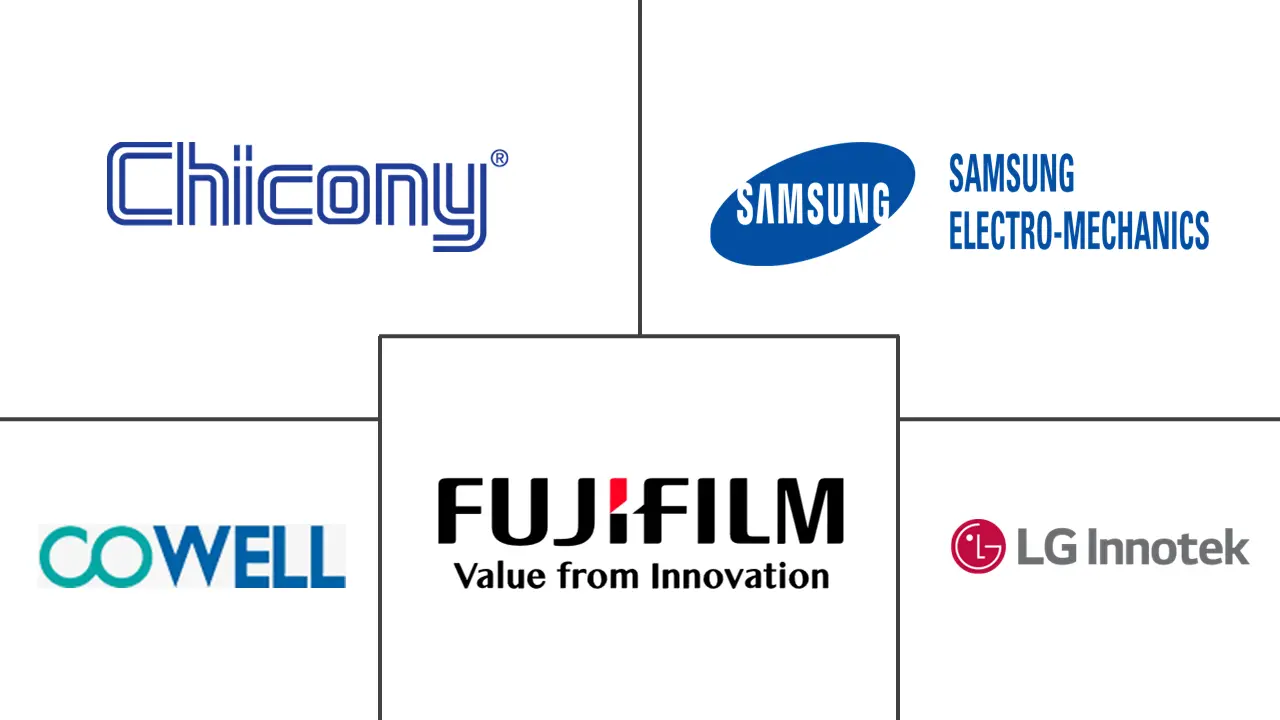Camera Module Market Size and Share
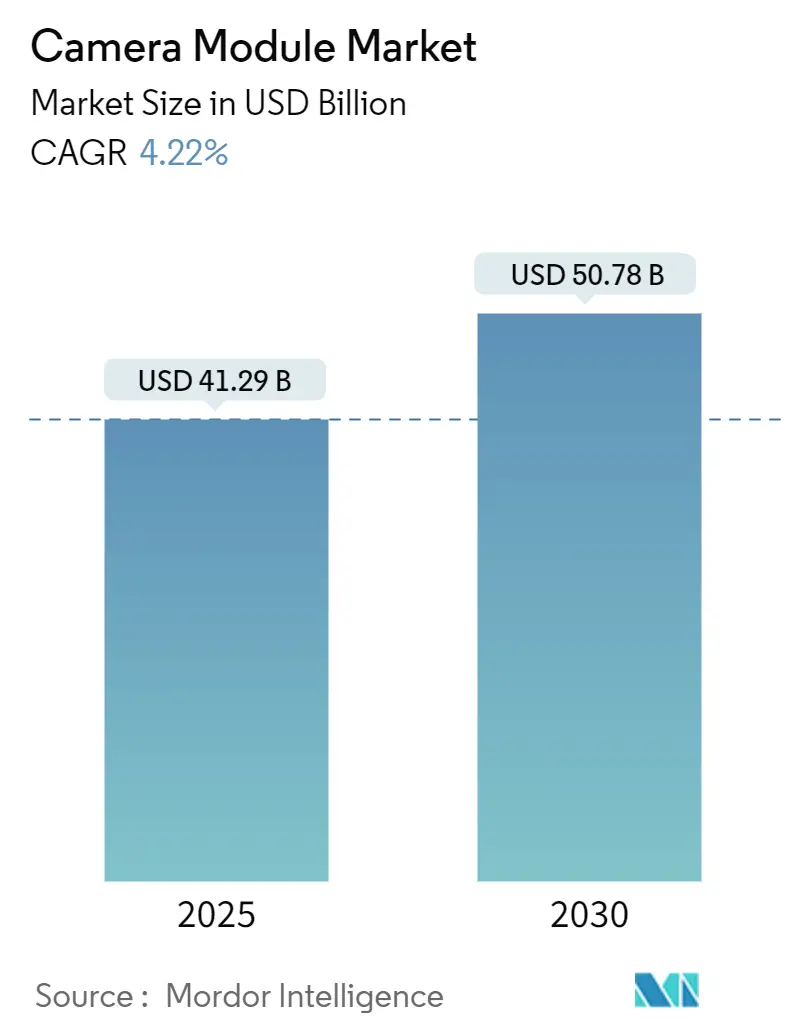
Camera Module Market Analysis by Mordor Intelligence
The camera module market is valued at USD 41.29 billion in 2025 and is forecast to reach USD 50.78 billion by 2030, reflecting a 4.22% CAGR over the period. Growth is shifting from pure volume expansion to feature-rich innovation, as handset saturation nudges manufacturers toward multi-camera arrays, folded-optics zoom, and on-device AI processing. Automotive safety mandates, edge-analytics surveillance, and emerging XR devices are broadening revenue streams beyond traditional mobile shipments. Component makers are prioritizing supply-chain resilience after the 2024 Taiwan earthquake exposed vulnerability in voice-coil motor (VCM) sourcing, while governments such as India are using production-linked incentives to localize assembly and attract fresh investment. Competitive intensity is rising as Korean, Japanese, and Chinese suppliers race to secure intellectual-property positions in high-value niches like under-display cameras and periscope modules.
Key Report Takeaways
- By geography, Asia Pacific held 59.7% of the camera module market share in 2024, whereas the Middle East & Africa region is projected to expand at 6.5% CAGR through 2030.
- By application, the mobile/smartphone segment accounted for 69.4% of 2024 revenue; the automotive segment is advancing at a 9.1% CAGR between 2025 and 2030.
- By component, image sensors contributed 48.8% revenue in 2024, while VCMs are set to grow fastest at a 7.2% CAGR over the forecast period.
- By pixel resolution, the 8–13 MP tier captured 34.7% camera module market size in 2024; resolutions above 13 MP are poised for a 6.8% CAGR to 2030.
- By manufacturing process, chip-on-board retained 63.7% revenue share in 2024; wafer-level packaging leads growth with an 8.1% CAGR outlook.
- By module form-factor, compact CCM designs commanded 83.6% of 2024 revenue, whereas MIPI-interface modules exhibit the highest forecast CAGR at 8.7%.
Global Camera Module Market Trends and Insights
Drivers Impact Analysis
| Driver | (~) % Impact on CAGR Forecast | Geographic Relevance | Impact Timeline |
|---|---|---|---|
| Multi-camera smartphone adoption (≥ 4 lenses) | +1.2% | China, wider Asia Pacific | Short term (≤ 2 years) |
| Rear-visibility and ADAS regulations | +0.9% | North America, Europe | Medium term (2-4 years) |
| Edge-AI surveillance for smart cities | +0.7% | Middle East, spillover to Asia Pacific & Europe | Medium term (2-4 years) |
| Periscope folded-optics integration | +0.8% | Global premium smartphones | Medium term (2-4 years) |
| PLI-driven local module assembly in India | +0.4% | India | Medium term (2-4 years) |
| 3D depth sensing for XR headsets | +0.6% | North America, South Korea | Long term (≥ 4 years) |
| Source: Mordor Intelligence | |||
Multi-camera smartphone adoption exceeding three lenses in Chinese flagships
Chinese handset brands have turned multi-camera arrays into mainstream specifications, pushing the average lens count toward five by 2025. Larger sensor footprints, dedicated ultra-wide and macro shooters, and periscope telephoto modules reinforce smartphones as primary imaging tools. Combined with computational photography, these arrays enable night-mode, portrait, and high-zoom features that differentiate devices in a saturated handset field. Domestic supply chains scale rapidly, pressuring incumbents while elevating the camera module market as a critical arena for brand identity and consumer upgrade intent. Huawei’s 200 MP periscope prototype illustrates the leap in optical ambition.[1]Huawei Central, “Huawei Testing 200 MP Periscope,” huaweicentral.com AI-driven computational photography squeezes more dynamic range and noise control from small pixels, letting brands market professional-grade imagery without larger sensors.
Rear-visibility and ADAS camera mandates (FMVSS 111, EU GSR)
Safety regulations in the United States and European Union have transformed rear-view and surround-view cameras from optional accessories into compulsory components. Automakers integrate multiple lenses to satisfy blind-spot monitoring, lane-keeping, and pedestrian detection requirements, generating recurring demand for ruggedized, temperature-tolerant modules. The US NCAP now scores blind-spot warning, lane-keeping assist, and pedestrian automatic emergency braking, raising baseline camera count per vehicle.[2]National Highway Traffic Safety Administration, “New Car Assessment Program Final Decision Notice,” nhtsa.gov Automakers therefore order surround-view systems that exceed compliance minimums, multiplying sensor nodes and propelling the camera module market.
AI-enabled edge-analytics surveillance roll-outs in Middle-East smart-city projects
Smart-city programs in the Gulf are deploying edge AI cameras that execute object detection, facial matching, and traffic analytics directly on the module. Manufacturers embed NVIDIA Jetson Orin NX or similar system-on-modules inside compact housings, eliminating latency associated with central servers and lowering bandwidth costs. Security integrators leverage these capabilities to deliver real-time incident alerts, crowd-density heatmaps, and license-plate recognition, positioning intelligent imaging as a pillar of urban-mobility and public-safety infrastructure. The resulting shift from hardware sales to recurring software and analytics subscriptions elevates lifetime revenue per deployment and bolsters the camera module market’s resilience across economic cycles. Entry-level i-PRO U-series models distill object detection and FIPS-grade security into sub-USD 400 units.[3]i-PRO Co. Ltd., “i-PRO Introduces U-series,” i-pro.com This edge pivot reduces bandwidth, tackles data-sovereignty laws, and grows module ASPs via integrated AI silicon.
Periscope/folded-optics boom elevating lens count per module
Folded-optics architectures redirect light through prisms and mirrors, enabling 4×–9× optical zoom without increasing handset thickness. Continuous-zoom implementations demonstrated by leading module suppliers deliver DSLR-like framing flexibility to smartphones. This innovation raises component counts and alignment tolerances, catalyzing investment in precision active alignment and automated calibration lines. The intellectual-property landscape is heating up as OEMs file patents for optically stabilized periscope assemblies, setting the stage for royalty-bearing cross-licensing and strategic alliances that will influence the camera module market’s profitability over the forecast horizon.
Restraints Impact Analysis
| Restraint | (~) % Impact on CAGR Forecast | Geographic Relevance | Impact Timeline |
|---|---|---|---|
| VCM actuator shortages after Taiwan earthquake | -0.7% | Global smartphone chain | Short term (≤ 2 years) |
| Wafer-level optics yield issues in under-display modules | -0.5% | Global flagships | Medium term (2-4 years) |
| Stacked CIS patent litigation | -0.4% | US, Japan, South Korea | Medium term (2-4 years) |
| EN 303 645 cyber-security compliance delays | -0.3% | European Union | Medium term (2-4 years) |
| Source: Mordor Intelligence | |||
VCM actuator supply constraints post-2024 earthquake in Taiwan
he 2024 seismic event disrupted a tightly clustered VCM ecosystem, triggering shortages that rippled through smartphone assembly lines worldwide. OEMs accelerated dual-sourcing and pursued piezoelectric alternatives that promise lower power draw and faster response times. Component makers embarked on geographic diversification, erecting capacity in Southeast Asia to de-risk future disasters. The episode also fueled vertical-integration strategies among leading Korean and Chinese suppliers, as access to critical actuators became decisive for premium-camera launch schedule. Alps Alpine disclosed profit pressure from procurement premiums and is diversifying into dual-site manufacturing.[4]Alps Alpine, “Integrated Report 2023,” alpsalpine.comPiezoelectric alternatives offer silent, low-power actuation and lower reliance on niche coil winders.
Wafer-level optics yield loss in under-display camera modules
Embedding cameras beneath active OLED pixels delivers uninterrupted screens yet imposes strict optical-path cleanliness and alignment requirements. Residue and particulate contamination during nanoimprint lithography for moth-eye antireflective layers drive yield loss, pushing production costs beyond mid-tier handset budgets. Research labs report incremental 3% transmittance gains via nanostructured coatings, but mass-production scaling remains limited. Consequently, under-display shooters stay confined to flagship devices, capping volume upside for relevant suppliers and tempering short-term growth for this emerging slice of the camera module market.
Segment Analysis
By Component: VCMs Drive Precision Revolution
VCM actuators underpin rapid autofocus and optical image stabilization, making them strategic levers for differentiating photo and video performance. The segment’s 7.2% CAGR surpasses the broader camera module market as handset brands spotlight low-light clarity and cinematic motion capture. Earthquake-induced shortages spurred exploration of piezoelectric and MEMS alternatives, yet VCMs retain cost and maturity advantages. Concurrently, image sensors held 48.8% revenue share in 2024, benefiting from stacked architectures that integrate on-sensor memory, enabling burst capture and multi-frame HDR. Advancements in back-side illumination have reduced noise floors, widening dynamic range for mobile and automotive applications.
Integration trends link VCMs with in-sensor phase-detection algorithms, allowing focus systems to swing from hardware to software symbiosis. Lens sets grow in complexity as folded-optics and variable-aperture designs proliferate, while module assemblers adopt active alignment robotics to hit micron-level tolerances. These changes reinforce the camera module market’s shift toward higher value per unit even as smartphone growth plateaus. Suppliers investing in actuator innovation and sensor-lens co-development position themselves at the premium end of the camera module industry’s margin curve.
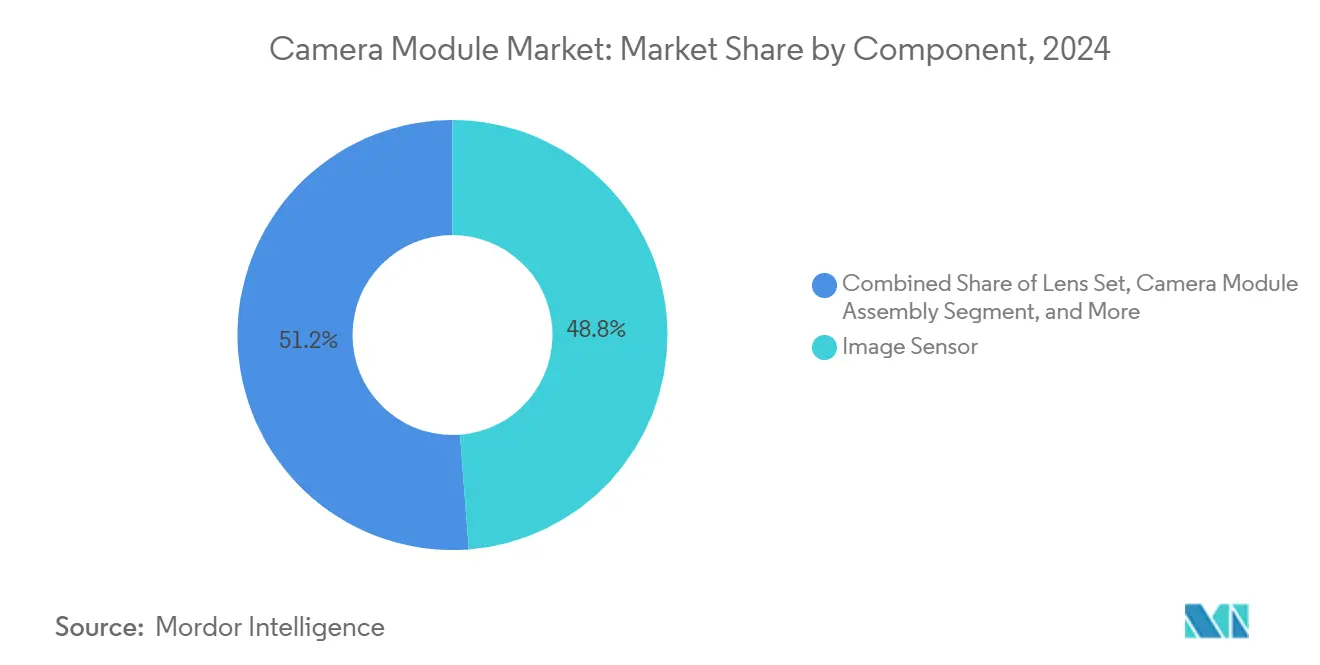
Note: Segment shares of all individual segments available upon report purchase
By Sensor Type: CMOS Dominance Drives Innovation
CMOS technology owns 90.1% of shipments, its single-chip integration and low power making CCD largely obsolete. Back-side-illuminated (BSI) variants lead the innovation front, expanding at 4.24% CAGR as they boost quantum efficiency for night-mode photography and autonomous-vehicle vision. High-dynamic-range (HDR) CMOS designs now leverage lateral overflow capacitors to capture extreme luminance ranges in a single exposure, satisfying stringent automotive safety requirements.
Three-dimensional stacking pushes processing logic under the photodiode plane, trimming signal paths and opening doors to neuromorphic, event-based sensing that outputs only pixel-level changes. Such architectures reduce bandwidth and energy demand, critical for edge AI deployments. Continuous CMOS optimization ensures the camera module market remains driven by sensor advances that cascade into entire imaging subsystems.
By Pixel/Resolution: Mid-range dominates while high-resolution accelerates
The 8–13 MP band remains the industry’s workhorse, controlling 34.7% revenue thanks to its balance of data load, battery drain, and perceived image clarity. Computational photography techniques upscale detail without proportionally larger files, letting OEMs prioritize software pipelines over larger pixel counts. Dual-gain sensors and multi-frame fusion extract superior dynamic range from mid-resolution hardware, reinforcing the segment’s dominance across cost-sensitive smartphones and IoT vision nodes.
Conversely, resolutions above 13 MP are climbing at a 6.8% CAGR, driven by flagship periscope cameras, medical imaging probes, and industrial inspection systems that need granular detail. Quad-Bayer pixel-binning enables these high-res sensors to toggle between full-resolution daylight capture and low-noise night shots, guarding power budgets. As module thickness constraints persist, innovations in micro-lens design and deep-trench isolation help maintain quantum efficiency, anchoring the camera module market size gains in premium tiers.
By Focus Type: Autofocus Capabilities Expand Applications
Phase-detection autofocus (PDAF) pixels embedded within CMOS arrays cut focusing times, boosting burst-shot hit rates in sports and action scenarios. Voice-coil motor precision improvements and closed-loop calibration algorithms ensure stable optical image-stabilization even at extended focal lengths. Liquid-lens prototypes promise millisecond refocus without moving parts, reducing wear and supporting rugged industrial deployments.
Fixed-focus modules still serve barcode scanners, entry-level laptops, and certain surveillance installations where broad depth of field suffices. Software depth estimation blurs backgrounds or sharpens critical regions on demand, blurring hardware segmentation lines. These developments widen the addressable space for the camera module market, letting vendors tailor focus performance to application-specific cost and reliability thresholds.
By Manufacturing Process: Packaging Innovations Drive Miniaturization
Chip-on-board (COB) lines deliver 63.7% of shipments by leveraging established tooling and yielding favorable cost curves for high-volume smartphone assembly. Yet the camera module market is witnessing a pivot toward wafer-level packaging (WLP) and flip-chip as OEMs demand slimmer profiles and tighter tolerances. WLP’s promise of lens-sensor co-alignment at the wafer stage eliminates post-singulation calibration, enabling z-heights compatible with foldable devices and AR glasses.
Moth-eye antireflective nanostructures etched via nanoimprint lithography have raised optical transmittance, mitigating under-display dimming penalties. Flip-chip offers an intermediate path, borrowing from semiconductor logic packaging to shorten electrical paths and reduce electromagnetic interference. Investment in advanced packaging differentiates suppliers and underpins premium-segment pricing in the camera module industry.
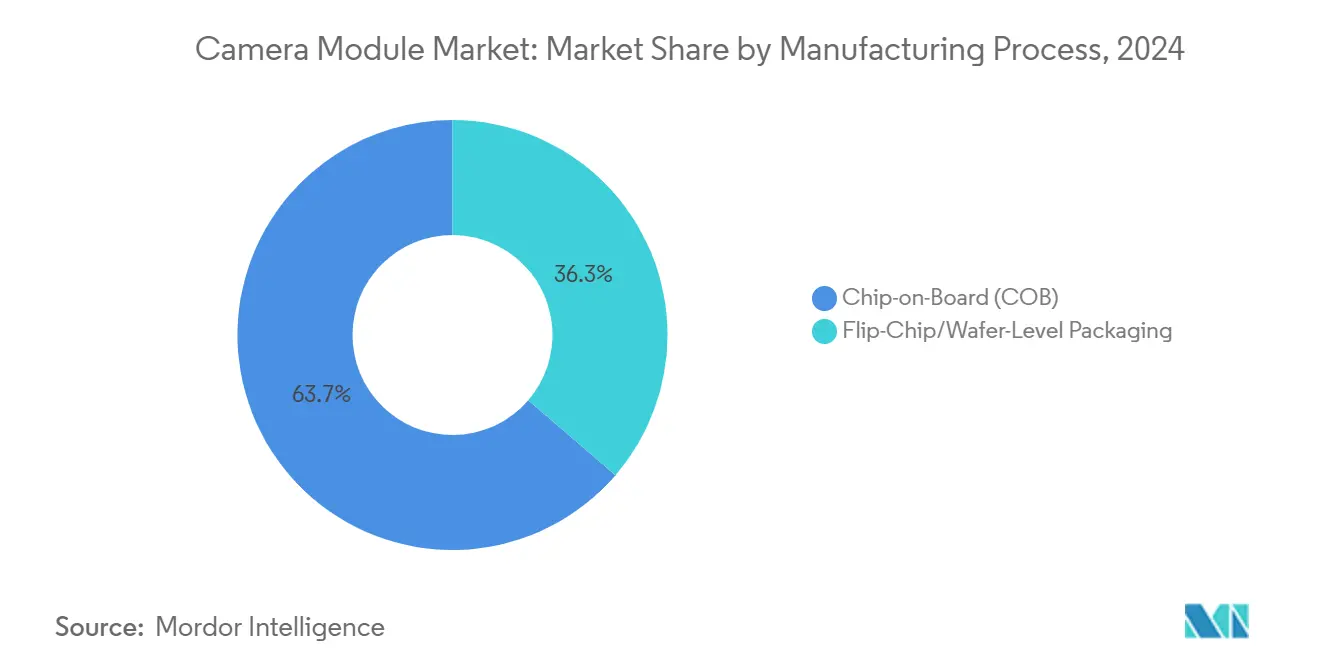
Note: Segment shares of all individual segments available upon report purchase
By Module Form-Factor: Integration Drives New Designs
Compact camera modules (CCM) dominate with 83.6% 2024 revenue, yet their internal layouts are evolving to host folded optics, larger sensors, and integrated AI accelerators. Prism-based periscope stacks enable 9× zoom within sub-7 mm thickness constraints, redefining optical possibilities for slim flagships. Active alignment machinery now positions multiple lenses and sensors in a single housing, trimming bill-of-materials and assembly time.
MIPI-interface modules are the fastest-growing slice at 8.7% CAGR, thanks to standardized CSI-2 and D-PHY links that streamline multi-camera orchestration in vehicles, drones, and industrial robots. Plug-and-play configurability accelerates design cycles and cuts qualification cost, inviting new entrants into the camera module market. Form-factor flexibility supports emerging uses such as dual-purpose cabin monitoring and facial-recognition doorbells, fueling incremental demand.
By Application: Smartphones Lead While Automotive Accelerates
Smartphones retain 69.4% of 2024 revenue, but unit growth has plateaued, shifting emphasis to richer camera feature sets and higher dollar-content per handset. The average cameras-per-device metric is projected to reach five by 2025, reinforcing the camera module market’s dependency on optical differentiation to trigger upgrade cycles. Computational imaging pipelines extend sensor capability, letting OEMs extract DSLR-like results from pocket-sized hardware.
Automotive modules, though smaller in volume, post the fastest 9.1% CAGR as regulators lock in rear-visibility and surround-view requirements. Custom polarization filters and high-dynamic-range sensors withstand glare, fog, and headlight reflections, preserving object detection accuracy. Healthcare, surveillance, and industrial robotics round out demand, each capitalizing on edge-analytics advances that convert raw pixels into actionable data. These cross-vertical gains stabilize market outlook against smartphone cyclicality.
Geography Analysis
Camera Module Market in North America
Asia Pacific controlled 59.7% of global revenue in 2024, propelled by dense supply chains spanning sensors in Japan and Taiwan, lens assemblies in mainland China, and finishing lines in Vietnam and India. New Delhi’s Production Linked Incentive program reimburses capital expenditure for domestic module assembly, enticing multinational contract manufacturers to localize production and shorten delivery times. Taiwan’s semiconductor depth supplies leading-edge logic for on-camera AI co-processors, reinforcing the region’s systemic importance.
North America and Europe combine premium handset demand with stringent vehicle-safety standards, underpinning stable requirements for high-reliability modules. US-based XR headset programs add incremental pulls for depth-sensing arrays, while the European Union’s EN 303645 cybersecurity baseline extends design cycles but yields hardened, upgradable connected cameras. Subsidy regimes for electric-vehicle autonomy further embed cameras as critical perception inputs.
Middle East & Africa, the fastest-growing region at 6.5% CAGR, banks on smart-city deployments in the Gulf that deploy edge AI cameras for traffic flow and public-safety analytics. Local integrators partner with global hardware vendors to roll out FIPS-compliant surveillance grids, catalyzing secondary demand for storage, compute, and network upgrades. South America offers longer-run upside as smartphone penetration rises and regional auto-safety standards converge with EU and US precedents.
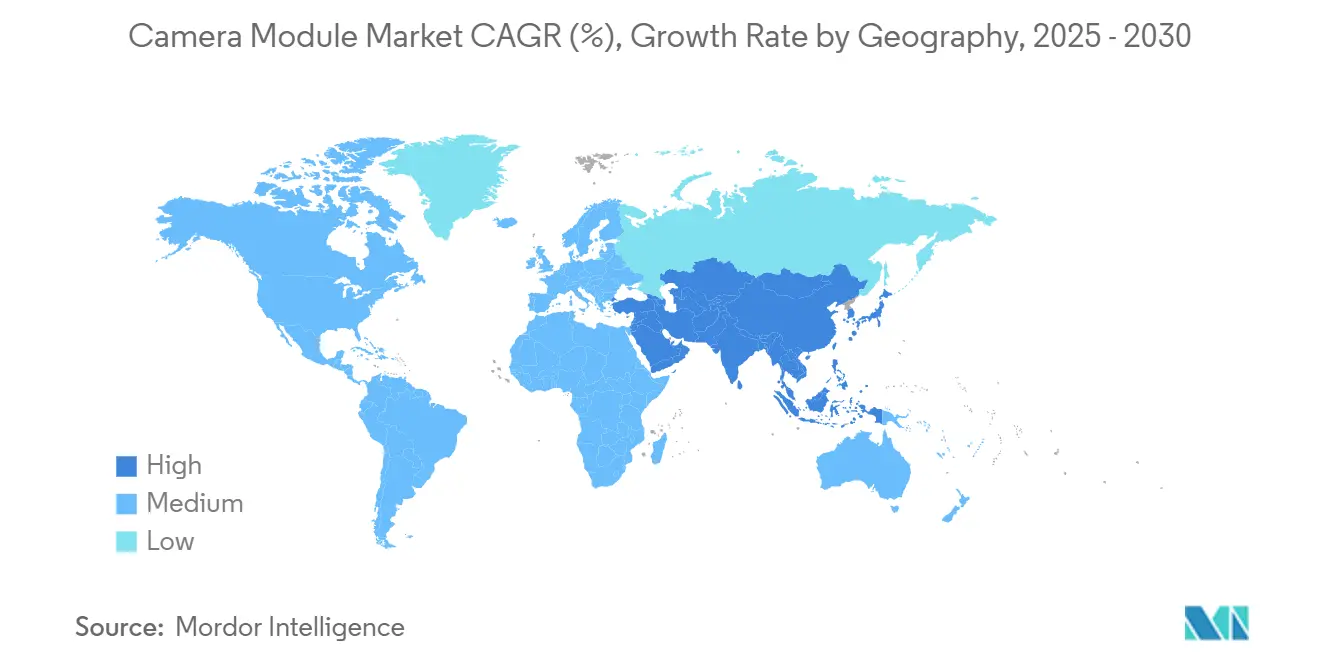
Competitive Landscape
Market concentration is moderate and trending upward as technical barriers climb. LG Innotek and Samsung Electro-Mechanics leverage scale and vertical control to secure flagship design wins across Korean and US handset brands. Sunny Optical and other Chinese contenders have closed quality gaps, aided by state-supported capital and aggressive patent filings in periscope zoom and under-display architectures. Intellectual-property disputes increasingly shape negotiations, with cross-licensing essential for multi-market access.
Strategic alliances link optics specialists to AI silicon partners, as exemplified by Advantech’s integration of NVIDIA Jetson modules into industrial cameras to create turnkey edge-analytics nodes. Component shortages drive larger players toward upstream investment: Korean conglomerates are building internal VCM and lens-barrel lines to de-risk supply, while Japanese sensor makers explore joint ventures with optics houses to deliver fully calibrated sub-assemblies. Niche innovators such as Omnitron Sensors target emerging long-range lidar and robotics markets with MEMS scanning mirrors, adding competitive diversity.
Over the next five years, success will hinge on mastering folded-optics alignment, wafer-level packing yields, and embedded AI acceleration. Vendors that combine differentiated silicon, precision mechanics, and secure firmware updates will capture disproportionate value as the camera module market tips toward smart-sensor ecosystems rather than discrete imaging parts.
Camera Module Industry Leaders
-
Chicony Electronics Co. Ltd
-
Cowell E Holdings Inc.
-
Fujifilm Corporation
-
LG Innotek Co. Ltd
-
Samsung Electro-Mechanics Co. Ltd.
- *Disclaimer: Major Players sorted in no particular order
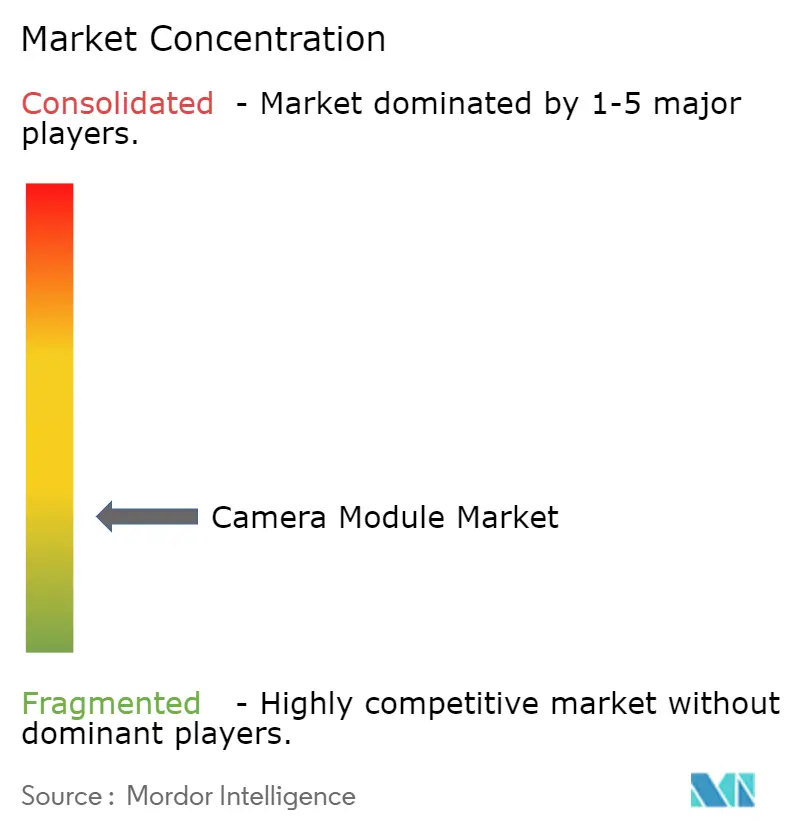
Recent Industry Developments
- May 2025: Huawei tested a 200 MP periscope camera aimed at flagship phones, lifting optical-zoom resolution ceilings.
- May 2025: Samsung’s camera module supplier forecast a 40% revenue boost on Galaxy S25 demand spikes.
- March 2025: i-PRO released U-series edge-AI cameras with FIPS 140-3 level 3 security certification.
- March 2025: Advantech launched the ICAM-540 all-in-one AI camera at NVIDIA GTC 2025, positioning it for material inspection on smart-factory lines.
- February 2025: India’s Union Budget granted full customs-duty exemption on camera modules, reducing local production costs.
Research Methodology Framework and Report Scope
Market Definitions and Key Coverage
Our study defines the camera module market as revenue generated worldwide from fully integrated sensor-lens-actuator assemblies supplied to smartphone, passenger-vehicle, industrial vision, security, and medical device makers. Values are captured at factory gate and include voice-coil motors and flex PCBs, while downstream image-signal processors sit outside the chain.
Scope Exclusion: Refurbished modules, stand-alone sensors, and optics sold separately are excluded.
Segmentation Overview
- By Component
- Image Sensor
- Lens Set
- Camera Module Assembly
- Voice-Coil Motor (AF and OIS)
- By Sensor Type
- CMOS
- CCD
- By Pixel/Resolution
- Up to 7 MP
- 8 - 13 MP
- Above 13 MP
- By Focus Type
- Fixed-Focus
- Autofocus
- By Manufacturing Process
- Chip-on-Board (COB)
- Flip-Chip/Wafer-Level Packaging
- By Module Form-Factor
- Compact/CCM
- MIPI-Interface Modules (CSI/DSI)
- By Application
- Mobile/Smartphones
- Consumer Electronics (ex-Mobile)
- Automotive
- Healthcare and Medical Imaging
- Security and Surveillance
- Industrial and Robotics
- By Geography
- North America
- United States
- Canada
- Mexico
- Europe
- Germany
- United Kingdom
- France
- Italy
- Spain
- Rest of Europe
- Asia-Pacific
- China
- Japan
- South Korea
- India
- South East Asia
- Australia
- Rest of Asia-Pacific
- South America
- Brazil
- Rest of South America
- Middle East and Africa
- Middle East
- United Arab Emirates
- Saudi Arabia
- Rest of Middle East
- Africa
- South Africa
- Rest of Africa
- Middle East
- North America
Detailed Research Methodology and Data Validation
Primary Research
Mordor analysts interviewed smartphone ODM engineers across Asia, European module assemblers, and North American ADAS procurement leads. These conversations refined yield drift, attach ratios, and near-term ASP curves that desk work alone could not surface.
Desk Research
We began with UN Comtrade HS-852580 trade flows, OICA light-vehicle output, and ITU handset-penetration tables, followed by safety texts from NHTSA and the EU GSR. Annual reports and 10-Ks of leading handset and tier-1 automotive suppliers revealed shipment clues and price bands.
Patent grids from Questel, Volza shipment logs, plus revenue splits in D&B Hoovers and Dow Jones Factiva completed the secondary lens. These titles are illustrative; many additional public records were reviewed for corroboration.
Market-Sizing & Forecasting
A hybrid top-down and bottom-up build anchors our baseline. Top-down demand pools stem from handset and car production, industrial camera installs, and CCTV roll-outs, which are multiplied by verified module-per-device ratios. Supplier roll-ups and sampled ASP × volume checks cross-verify totals before convergence. Five forward variables, 5G handset mix, ADAS penetration, pixel-upgrade cadence, subsidy schemes, and localization incentives, feed a multivariate regression that extends the view to 2030.
Data Validation & Update Cycle
Outputs clear peer review, variance checks against trade and production lines, and fresh primary callbacks whenever anomalies appear. Reports refresh annually, and material events trigger mid-cycle updates so clients always see the latest view.
Why Mordor's Camera Module Baseline Commands Reliability
Published estimates often differ because each firm picks its own component mix, ASP ramp, and refresh cadence.
Our disciplined scope and yearly resets hold variance in check.
Benchmark comparison
| Market Size | Anonymized source | Primary gap driver |
|---|---|---|
| USD 41.29 B (2025) | Mordor Intelligence | |
| USD 56.24 B (2025) | Global Consultancy A | Adds discrete ISP chips and internal transfer pricing |
| USD 47.74 B (2024) | Industry Publisher B | Uses high ASP inflation with optimistic handset recovery |
| USD 34.95 B (2025) | Regional Consultancy C | Leaves out healthcare and security modules |
These contrasts show that once scope alignment slips, figures drift, whereas Mordor's transparent variables and repeatable checks give decision-makers a balanced, dependable baseline.
Key Questions Answered in the Report
What is the current size of the camera module market?
The market is valued at USD 41.29 billion in 2025 and is expected to reach USD 50.78 billion by 2030.
Which application accounts for the largest revenue share?
Mobile and smartphone cameras dominate with 69.4% of 2024 revenue, driven by multi-camera smartphone adoption trends.
Why is the automotive segment considered the fastest growing?
Regulatory mandates like FMVSS 111 and EU GSR are making rear-visibility and ADAS cameras compulsory, propelling a 9.1% CAGR from 2025 to 2030.
Which packaging technology is gaining traction for ultra-thin modules?
Wafer-level packaging is the fastest-growing approach at an 8.1% CAGR, enabling thinner profiles and precise lens-sensor alignment for emerging devices
How did the 2024 Taiwan earthquake affect the industry?
It disrupted VCM actuator supply, exposing single-source vulnerabilities and prompting OEMs to diversify sourcing and explore piezoelectric alternatives.
What regional policy is boosting local camera module production in India?
India’s Production Linked Incentive scheme and a 2025 customs-duty exemption on modules are incentivizing domestic assembly and lowering manufacturing costs.
Page last updated on:
